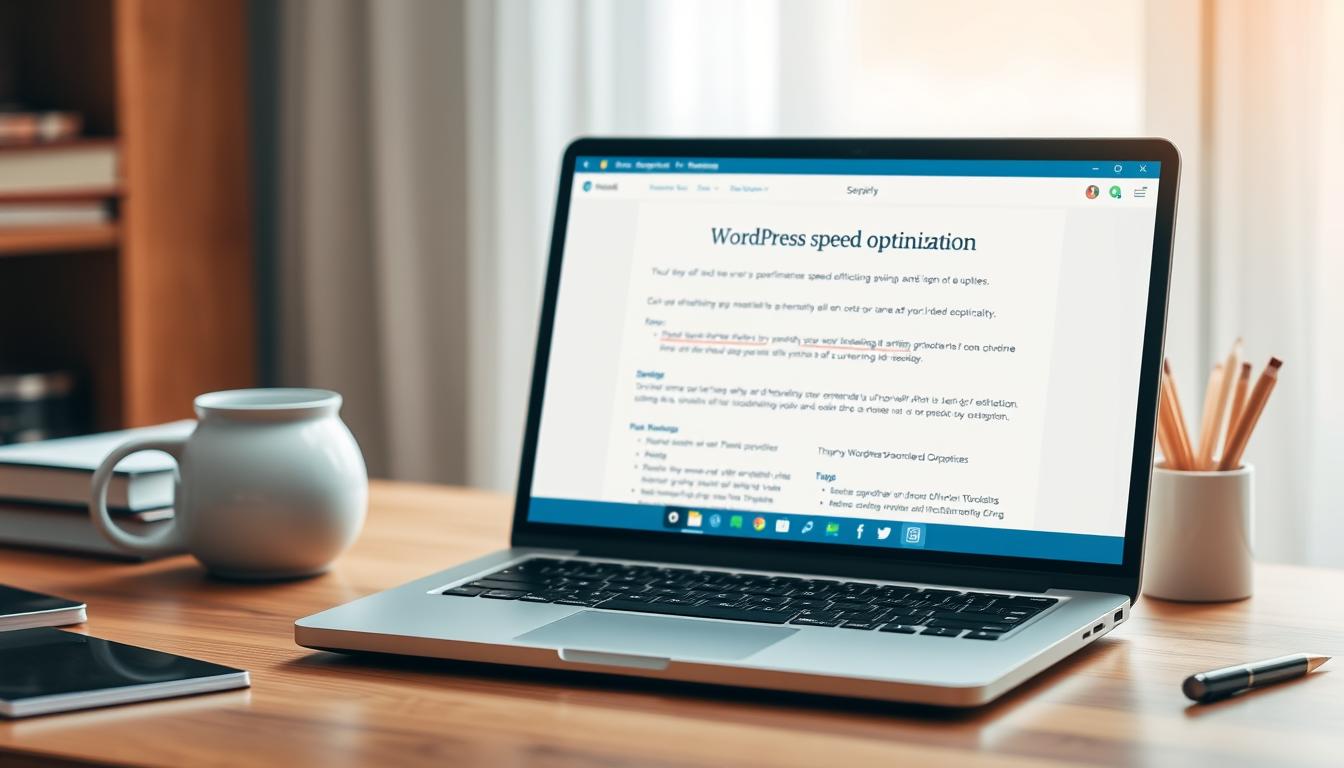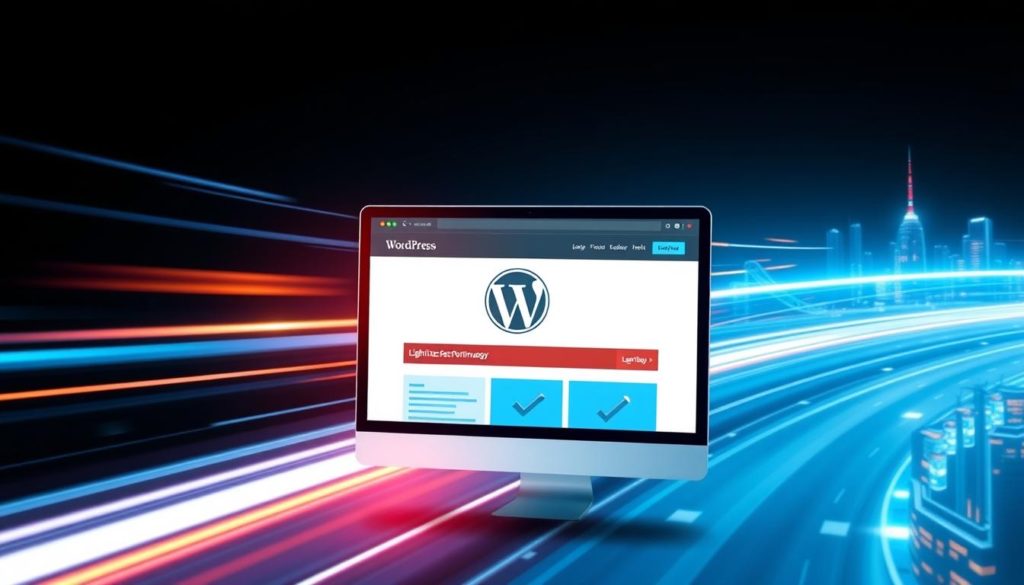
What if your website’s loading time is silently costing you customers and revenue? Studies reveal 53% of mobile visitors abandon pages that take longer than three seconds to load. With Google prioritizing speed in search rankings and users expecting instant results, slow performance isn’t just inconvenient—it’s a business liability.
Modern audiences demand seamless experiences. A one-second delay can trigger a 7% drop in conversions and 16% fewer satisfied customers. For WordPress platforms, dynamic content generation adds complexity, making optimization both urgent and challenging.
This guide delivers practical solutions for boosting site performance. Whether you’re troubleshooting lagging pages or overhauling technical infrastructure, you’ll discover strategies to meet Google’s two-second load benchmark. Transform your platform into a high-speed asset that retains visitors and climbs search rankings.
Key Takeaways
- Over half of mobile users abandon sites that load slower than 3 seconds
- Google prioritizes fast-loading websites in search results
- 1-second delays reduce conversions by 7% and customer satisfaction by 16%
- WordPress sites require specialized optimization for dynamic content
- Speed improvements directly impact revenue and search visibility
- Both basic and advanced optimization techniques will be covered
Introduction to WordPress Speed Optimization
The flexibility of WordPress comes with hidden performance costs. Unlike basic HTML pages, every visitor triggers a complex assembly line. The platform pulls data from databases, processes theme templates, and compiles PHP scripts to build pages in real time.
This dynamic approach creates three critical challenges. Server resources strain under repeated page generation. Unused plugins drain processing power silently. Theme features often load unnecessary code for simple functions.
Optimization becomes vital when considering mobile users and search rankings. Sites using outdated caching methods waste milliseconds during peak traffic. Bloated media files compound delays caused by database queries.
Strategic improvements address both technical and user-facing issues. Proper hosting configurations reduce server response times. Smart caching stores pre-built pages for instant delivery. Code minification streamlines theme and plugin operations.
Every WordPress website exists on a performance spectrum. Regular audits identify resource-heavy elements. Selective plugin use prevents feature overload. These steps transform sluggish platforms into responsive digital assets.
Understanding Website Speed and User Experience
Digital patience wears thin at two seconds. Google’s research confirms this threshold as the breaking point where visitors disengage. With 15% of Americans relying solely on mobile devices, slow-loading pages risk alienating a growing audience segment.

Impact on Conversions and SEO
Speed directly shapes financial outcomes. For every second saved, conversion rates climb 17% – a margin that separates thriving businesses from stagnant ones. Search engines amplify this effect through Core Web Vitals, prioritizing sites that deliver instant responses.
Consider these critical connections:
- 53% higher bounce rates occur when pages take 3+ seconds to load
- Mobile-first indexing penalizes sluggish sites in search rankings
- Visitors judge site credibility within 50 milliseconds of arrival
Why Fast Load Times Matter
Modern users equate speed with competence. A lagging site triggers subconscious doubts about security and professionalism. Mobile audiences prove particularly impatient, often accessing content through unstable cellular networks.
Performance influences more than initial visits. Returning users expect consistent responsiveness, and 79% will abandon purchases after poor experiences. Fast-loading pages foster trust, encouraging deeper exploration and repeat engagement.
Essential Tools for Measuring Website Performance
Accurate diagnostics separate guesswork from genuine improvements. Measuring site responsiveness requires specialized instruments that reveal hidden bottlenecks and optimization opportunities.
Popular Speed Testing Tools
Google PageSpeed Insights evaluates Core Web Vitals across devices, generating actionable reports for mobile and desktop versions. It prioritizes fixes based on their impact on user experience.
WebPageTest delivers granular insights through waterfall charts. These visual timelines expose resource-loading sequences, helping pinpoint delays in scripts or media files. Multiple test locations simulate global access conditions.
GTmetrix merges Lighthouse and PageSpeed data for comprehensive audits. Its filmstrip view illustrates content rendering stages, while detailed metrics track improvements over time.
Platform-specific solutions like WP Engine’s speed test analyze WordPress configurations. They identify plugin conflicts and server-level issues unique to CMS platforms.
Critical metrics demand attention:
- TTFB measures server reaction speed
- FCP indicates initial content visibility
- LCP tracks main content readiness
Regular testing across devices and regions ensures consistent performance. Monthly audits catch emerging issues before they affect conversions or rankings. Data-driven adjustments maintain peak responsiveness as content evolves.
How to Create Fast WordPress Sites
Website configuration adjustments intimidate many beginners, but strategic optimization unlocks measurable results. Start by establishing performance baselines using tools like GTmetrix or WebPageTest. These diagnostics reveal critical metrics including server response times and resource-loading sequences.

Layered improvements deliver cumulative benefits. Server upgrades reduce processing delays, while caching plugins store pre-built pages for instant delivery. Content delivery networks (CDNs) distribute assets globally, slashing load times for international visitors.
Non-technical users achieve significant gains through smart plugin selection. Tools like WP Rocket automate caching configurations and code minification. Image optimization plugins compress media files without quality loss, while lazy loading delays off-screen content rendering.
Regular maintenance sustains peak performance. Schedule monthly audits to identify bloated databases or outdated themes. Monitor Core Web Vitals through Google Search Console to maintain search ranking advantages. Every adjustment contributes to faster interactions and improved visitor retention.
Prioritize hosting environments designed for CMS platforms. Managed solutions offer built-in caching and security features. Pair these with lightweight themes and selective plugin use to maintain lean operations. Continuous refinement keeps platforms competitive as traffic patterns evolve.
Choosing a Reliable Hosting Provider
Your website’s foundation determines its maximum potential speed. Like building skyscrapers on bedrock, selecting the right hosting infrastructure prevents performance collapses under traffic pressure.

Resource Allocation Matters
Shared hosting splits server capacity among multiple sites. While budget-friendly for new projects, neighboring traffic surges can throttle your loading speeds. One popular blog on the same server might consume resources needed for your pages.
Dedicated servers and VPS solutions eliminate this uncertainty. These environments guarantee processing power and memory allocation. Managed WordPress hosting takes this further with:
- Pre-configured caching systems
- Global CDN networks
- Automatic security updates
Geographic proximity between servers and visitors shaves milliseconds off load times. US-based audiences benefit most from domestic data centers using SSD storage and modern processors. Technical support teams specializing in CMS platforms can resolve speed issues faster than generic providers.
Upgrading hosting plans often delivers immediate performance improvements. Monitor server response times after migration – sub-500ms benchmarks indicate robust infrastructure.
Updating and Optimizing WordPress Core, Themes, and Plugins
Behind every high-performing website lies a critical maintenance routine. Regular updates to core software, themes, and plugins keep platforms secure while enhancing speed. Neglecting these updates risks security breaches and performance degradation.
Modern platforms require PHP 7.4 or higher for optimal operation. This version processes requests 30% faster than older iterations while using fewer server resources. Outdated PHP versions create unnecessary bottlenecks in page generation.
| Component | Update Benefits | Performance Impact |
|---|---|---|
| WordPress Core | Security patches | Reduces server load |
| Themes | Code optimization | Faster rendering |
| Plugins | Bug fixes | Lower memory usage |
Automated update tools simplify maintenance without compromising stability. Solutions like Jetpack Manage provide version control and instant rollback features. Always test updates in staging environments before deploying site-wide changes.
Theme developers frequently streamline code structures in new releases. These improvements help browsers render pages quicker while reducing CSS conflicts. Similarly, plugin updates often resolve compatibility issues that drain processing power during peak traffic.
Consistent maintenance preserves both speed and security. Schedule monthly audits to identify outdated components. Pair updates with performance monitoring to measure their impact on loading times and user experience.
Database Optimization and File Cleanup
Hidden digital clutter accumulates like dust in forgotten corners of your platform. Every edit, plugin test, and abandoned draft leaves traces that slow critical operations. This invisible burden strains server resources and extends query processing times.
Controlling Content Version History
WordPress automatically saves post drafts and updates. While useful for recovery, these snapshots multiply rapidly. A single article with 20 revisions consumes 20x more storage than its final version.
| Revisions | Storage Used | Query Speed |
|---|---|---|
| Unlimited | High | 1.8s |
| Limited (4) | Medium | 1.2s |
| Disabled | Low | 0.9s |
Add define( 'WP_POST_REVISIONS', 4 ); to your wp-config.php file. This preserves recent edits without overwhelming your database. Combine this with monthly cleanup routines for expired transients and pingbacks.
Eliminating Digital Debris
Unused plugins often leave tables and settings behind. Spam comments accumulate like uninvited guests, while orphaned media files waste storage. Tools like WP-Optimize automate removal of:
- Deactivated plugin data
- Post auto-drafts
- Trashed items
Manual cleanup requires caution. Always back up databases before deleting records. Optimized data structures improve backup speeds by 40% and reduce server load during traffic spikes.
Lightweight Themes and Quality Plugins
Visual appeal shouldn’t compromise functionality. Many WordPress themes load excessive scripts and unoptimized assets that strain server resources. Clean code structures in performance-focused designs reduce processing demands while maintaining essential features.
Theme selection directly affects loading speeds. Bloated options often include unused animations, redundant widgets, and oversized media libraries. These elements increase HTTP requests and delay content rendering across devices.
| Theme Type | Key Features | Average Load Time | Code Quality |
|---|---|---|---|
| Multipurpose | 50+ templates | 4.2s | Medium |
| Lightweight | Essential modules | 1.8s | High |
| Custom-Coded | Tailored functions | 1.1s | Premium |
Plugin efficiency separates useful tools from performance drains. Well-maintained WordPress plugins execute tasks with minimal code execution. They activate resources only when needed and follow strict coding standards.
Audit active extensions quarterly. Remove redundant tools and replace resource-heavy options with streamlined alternatives. Each plugin should serve clear purposes without overlapping functions.
Regular maintenance preserves site responsiveness. Combine theme updates with database optimization for cumulative speed gains. Prioritize components receiving consistent developer support and security patches.
Image Optimization and Media Management
Visual content drives engagement but often slows digital experiences. Unoptimized media files account for 42% of page weight on average, directly impacting site responsiveness. Strategic formatting and compression balance quality with speed.
Compression Techniques and Tools
Modern plugins automate image optimization without quality loss. Solutions like Smush reduce file sizes by 60% through intelligent compression algorithms. Bulk processing features handle existing media libraries efficiently.
Lossy compression works best for photos, removing invisible metadata. Lossless methods preserve exact details for infographics and product images. Always test outputs across devices to maintain visual integrity.
Choosing the Right Image Formats
JPEG remains ideal for photographs with complex color gradients. PNG suits graphics requiring transparency or sharp text displays. WebP delivers 30% smaller files than JPEG but requires plugin support for full compatibility.
Implement lazy loading to defer off-screen content. Set maximum dimensions during upload to prevent oversized files. Regular audits identify unoptimized assets dragging down site performance.
Proper media management cuts page load times by 1-3 seconds. Combine format selection with CDN delivery for global speed consistency. Every kilobyte saved accelerates content delivery and improves user retention.
